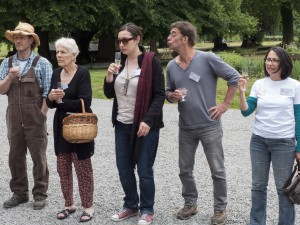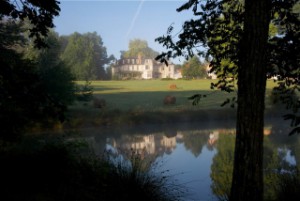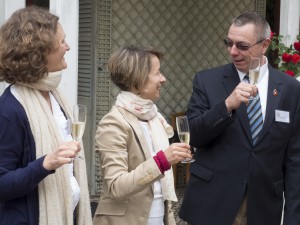Monday
International ProgramsDechen Choling Succeeds
 Celebrating 20 Years of Dechen Choling
Celebrating 20 Years of Dechen Choling
article by Acharya David Schneider, Cologne, Germany
Asked to contribute some words to the celebration of 20 years of Dechen Choling from the perspective of Shambhala Europe, the first point is that my having been the Director — and our having moved (my then-wife Melissa Moore and me) to Europe at all — is entirely because of Dechen Choling (DCL).
“They’ve just bought this land center,” the Sakyong said at dinner in San Francisco one night in late 1994, “and they’ve got to get it going.” There was a feeling of “or else” in his understatement, although he did not detail the risks. Nor did he say, a few days later, when he invited me to be the Director of Shambhala Europe (SE) that the administration, such as it was, was in bad shape, though this was immediately obvious when I came over for an exploratory visit in January of 1995.
Shambhala Europe (SE) was of course in debt, having just bought this property in France, and before that, having repeatedly flown SE Council members to various corners of Europe in search of the right place. The Council was geographically dispersed: Shambhala Training was administered from Saarbrucken, in coordination with Marburg. Bookkeeping took place in Marburg, but larger financial pictures and decisions about them were framed in Amsterdam. Buddhist programs were run out of Marburg. There was no Nalanda Gate to speak of, but a lot of energy for it bubbled in London.
This impractical plan had been put in place, apparently, as a safeguard against one nationality dominating things, seizing power. Of course Marburg had long been accused of doing exactly that, and the administration there (including, now, me) was viewed very skeptically by SE members in France, Netherlands, England, Austria, Spain, Switzerland, and even in some of the smaller, less central German towns.
Communication was clumsier then. Email was in its infancy, not the functioning tool it would later become. International phone calls were expensive, so we generally faxed. (It blew my mind when I heard a Dutch friend pronounce this word — it sounded, to my American ear, exactly like she said, “I fuckst him about that. Yes, then he fuckst me right back, with this.”) Rumor and slander however seemed to travel at lightning speed, especially along nationalist lines. People still clung to more or less applicable stereotypes: Germans are like this; Dutch are like that; French people do things this way — except in Paris, where they do it that way; English people — well, it’s an island, isn’t it?; Austria — who? where? how many? All of this hampered cooperation, and in the face of its real and pressing problems, SE needed cooperation.The money back then was different: we didn’t have the Euro yet, so one was constantly converting: DM to pounds sterling to francs to guilders to pesos to dollars to you name it. Any attempt to collect funds meant that the banks took their own hefty cuts. My predecessor, the Ambassador Plenipotentiary, Mr. Steven Baker, whose abrupt departure from Marburg had led to the new system told me very few things before I came over. One of them was: “There’s a reason they have different countries over there — they’re different!” My own experience with this was both yes and no. In any case, it was a problem.
And at DCL?
The Sakyong had asked a very capable French & Canadian architect — Mrs. Catherine Eveillard — to oversee the renovation of the place, and she had been doing a marvelous job since she arrived in 1994. A great deal of money however had gone into essentially invisible work: redoing the ancient electrical wiring; redoing and bringing up to code the plumbing; putting in heating. Crucial work absolutely, but largely invisible.
The Sakyong had not appointed a Director of DCL, and decisions were necessarily being taken on the spot that would affect the look and functioning of the place for decades. Catherine’s indefatigably cheerful husband — long-time student and fine artist Herb Elsky — had gotten and kept the practice going, though it was an unpredictable, transient group who might or might not appear for the morning sitting. At what time? In which room? Which one is that, again? Catherine and Herb were also raising a very new baby, Felix. (His middle name, Dechen, reveals his early connection with the place.)
 I went to DCL as often as I could: assembled council meetings there, and donor meetings, and legal meetings, but travel in 1995 also took longer. Reaching DCL from any European city other than Paris required a full day’s travel at the very least, and from Paris, it was usually a full five hours minimum. If I have emphasized obstacles and difficulties so far, it’s because that’s what a Director mostly sees. Very rarely — if ever! — did anyone call in to report, “Things are going well here, no problem!”
I went to DCL as often as I could: assembled council meetings there, and donor meetings, and legal meetings, but travel in 1995 also took longer. Reaching DCL from any European city other than Paris required a full day’s travel at the very least, and from Paris, it was usually a full five hours minimum. If I have emphasized obstacles and difficulties so far, it’s because that’s what a Director mostly sees. Very rarely — if ever! — did anyone call in to report, “Things are going well here, no problem!”
But there was tremendous pride throughout the European sangha that we now had our own practice place. We were just going to make it work, regardless of the challenges. The Sakyong as well gave DCL special attention. It was after all the first practice center he’d put in place; the rest having been established by his father. He made it my number one priority as Director:
1. Get DCL going
2. Strengthen the existing centers
3. Develop and reach out to new centres.
With an astonishing display of insight, intuition, wisdom, generosity (and all the other paramitas) the European Shambhala community not only got DCL going — they repaired it, purified it, refined it, deepened, broadened and beautified it, all of which continues to this very day. An inspiration.
Having painted a one-sided picture of difficulties at the beginning, let me offer another snapshot, one that may give a balancing view, from 5 or 6 years later. At this time, the Sakyong was using what we call “the Garuda room” in “the Suite” for interviews and business. On this day, he’d just finished a long series of interviews prior to a Bodhisattva Vow ceremony scheduled the following day. He’d allowed me to be in the room for the sensitive business of picking out a name for each person. This was part of ongoing archarya education. Also in for the interviews had been one of the traveling secretaries, Ms. Susan Dreier, writing down the names. The Sakyong sat in a prototype double-wide emperor’s style couch-chair he now uses for interviews.
In his personal room, to which we walked a few steps, instead of the emperor’s chair, was a large, high bed. He was staying on the DCL land for programs, though this severely limited his mobility, as people would constantly approach him with questions if he went for a walk or to inspect some particular aspect of the property. We were now only retiring to his room for a short break though (bathroom necessities) and to allow for a presentation to be prepared in Garuda. Mdm Eveillard was to present the short – and long-term development plans for DCL as she’d envisioned them from instructions he’d left her last time. This involved (at least) large, complicated, and beautiful architectural drawings, and, I think, a maquette as well — a 3-D scale model — to show what would go where, and to allow the Sakyong to walk around it and contemplate it at his leisure.
He emerged from his bathroom, reclined on the bed and said to me, and to Ms. Dreier, who had by now also entered the room, and to a kusung, who’d brought in a pot of tea, “You know, I was thinking that Dechen Choling has already done its job. It’s already succeeded. It’s already done.”
“Sir?” I asked in some wonder, after debating a couple seconds if I’d heard him correctly.
 While he’d been in the bathroom thinking of success, I’d been in fact contemplating the fact that his room, while it did now have some covering on the floor, had neither the color nor style he’d suggested on his previous visit, and how the same was true of the large (and lovely) Louis 14-style chair that had been purchased for his room, despite the simple English wing-back he’d suggested. Like a director, I was thinking about what was wrong, what had not been done, if it could be repaired, and whose fault it had been.
While he’d been in the bathroom thinking of success, I’d been in fact contemplating the fact that his room, while it did now have some covering on the floor, had neither the color nor style he’d suggested on his previous visit, and how the same was true of the large (and lovely) Louis 14-style chair that had been purchased for his room, despite the simple English wing-back he’d suggested. Like a director, I was thinking about what was wrong, what had not been done, if it could be repaired, and whose fault it had been.
“Yes, sure, we can continue to develop and build out the place — probably we should — but basically it’s already pretty good. It’s already kind of done.”
He did not elaborate, and in fact changed the topic, leaving me to contemplate in the next hours and days and weeks how indeed, although many problems remained for both DCL and SE, general cooperation was better, continent wide; and how the hours of practicing together at DCL, rooming together, cooking and cleaning and celebrating together had knit the European sangha closer than I’d ever seen it, and had particularly helped to diminish the undignified grip of nationalistic prejudice.
Friendships arose across national borders at DCL, and partnerships. Romances bloomed too between residents of geographically diverse countries. Maybe DCL had already done its job. Still, we soon walked back down the hall to see plans for the next phases of development.





